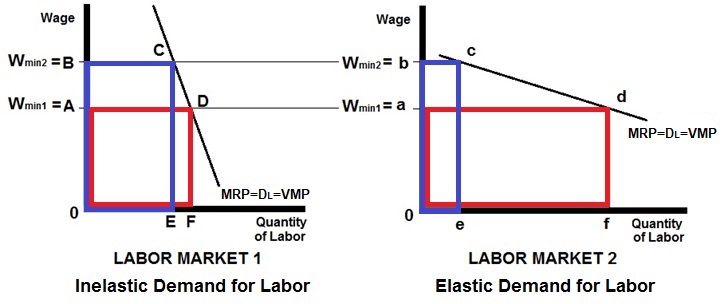|

EXPLANATION/ CHARACTERISTICS /
RESULTS
- To keep things simple we assume a
competitive product market so Dlabor = MRP = VMP
- The traditional minimum wage model
predicts less employment, but will the poor be better off
even though more are unemployed? Will their total incomes be
higher?
- It depends on the price elasticity
of demand for labor
- If the demand for labor is
INELASTIC (see Labor Market 1 graph) :
raising the minimum wage from A to B
will increase incomes from 0ADF to 0BCE (red to blue). This
is good for the working poor.
- If the demand for labor is ELASTIC
(see Labor Market 2 graph):
raising the minimum wage from A to B
will decrease incomes from 0adf to 0bce (red to blue). This
is bad for the working poor.
- Determinants of elasticity of labor
demand (review from lesson 12a)
1. Ease of Labor
Substitutability
- If there are MANY
SUBSTITITES for labor, then the demand for labor is MORE
ELASTIC
- If there are FEW SUBSTITUTES for
labor, then the demand for the labor is LESS
ELASTIC
2. Elasticity of Product
Demand
- If demand for the
product is MORE ELASTIC, then the demand for the labor
used to produce the product is MORE ELASTIC
- If demand for the product is
LESS ELASTIC, then the demand for the labor used to
produce the product is LESS ELASTIC
3. Labor-Cost to Total-Cost
Ratio
- If the labor cost is a
LARGE FRACTION of the total costs, then the demand for
labor is MORE ELASTIC
- If the labor cost is a SMALL
FRACTION of the total costs, then the demand for labor is
LESS ELASTIC
|